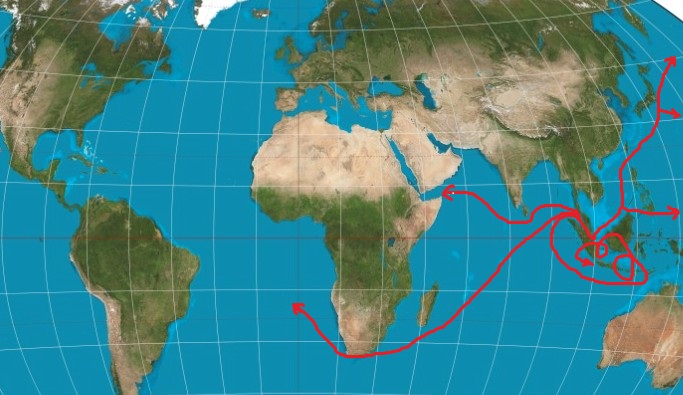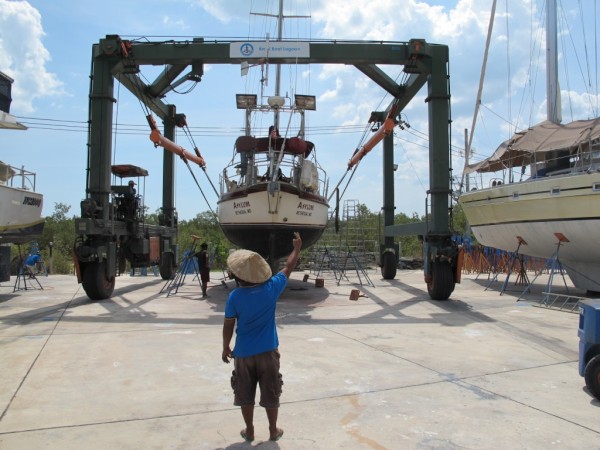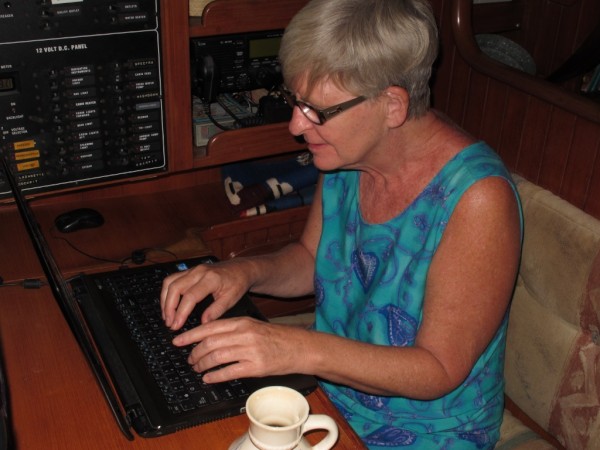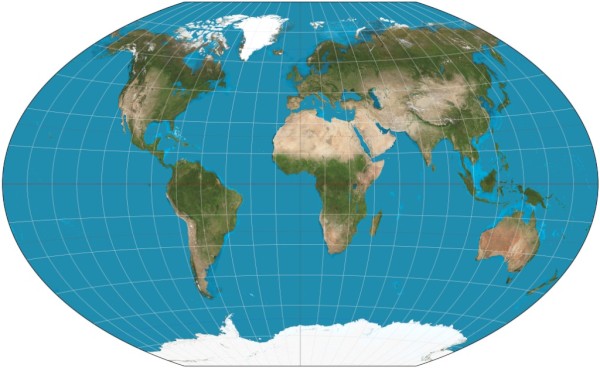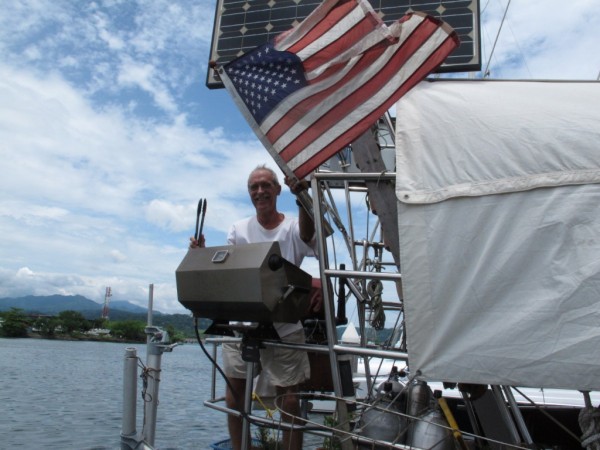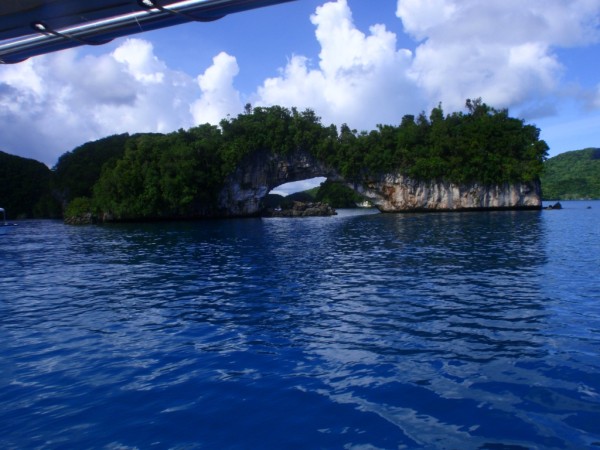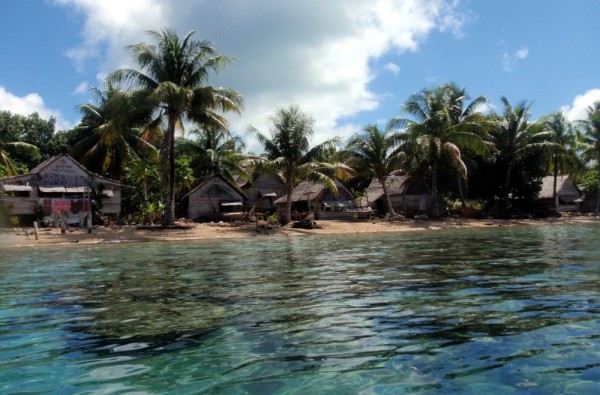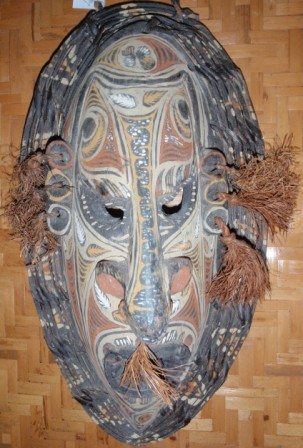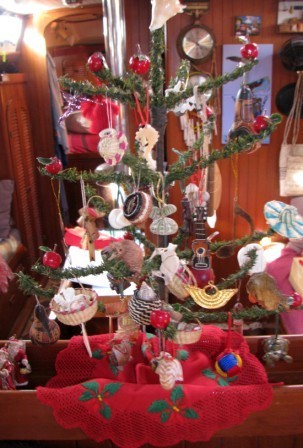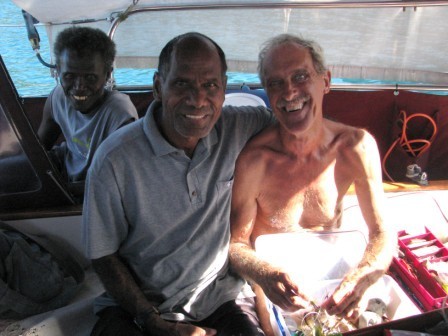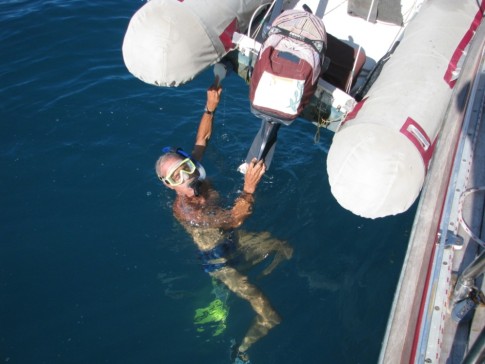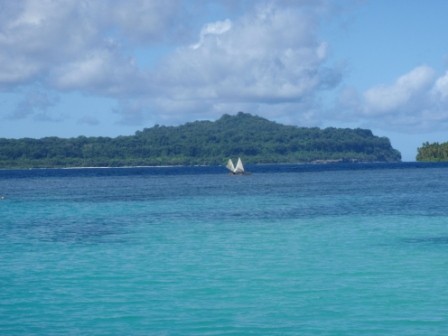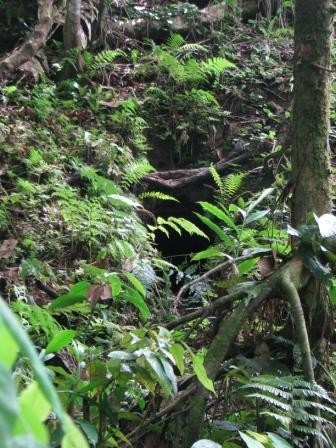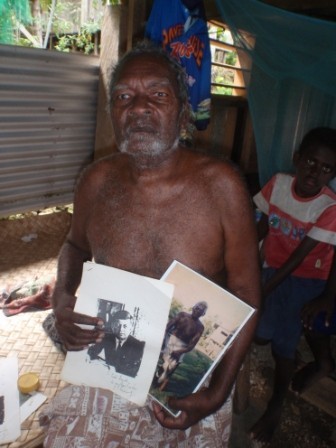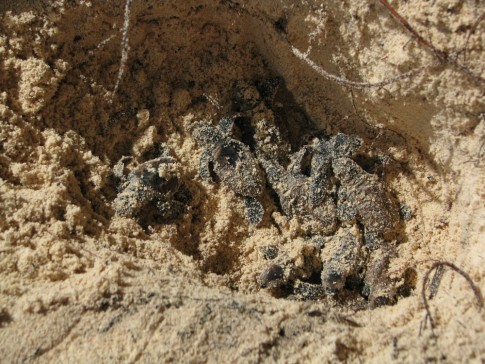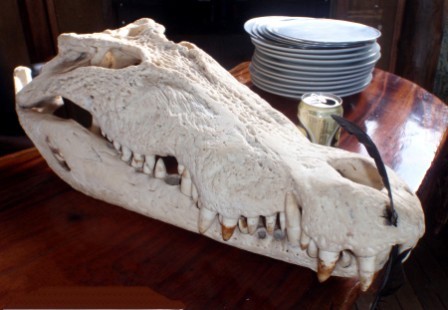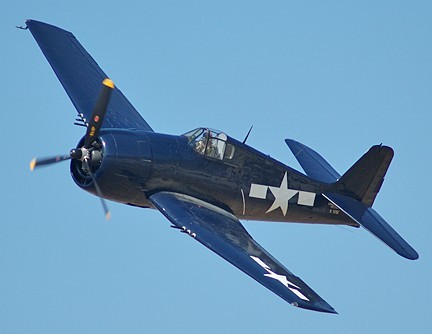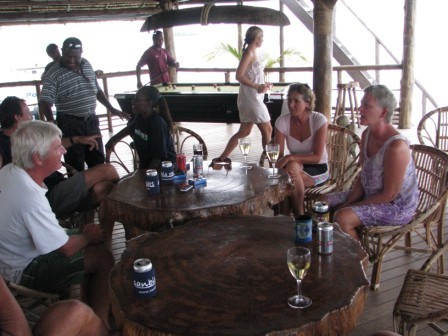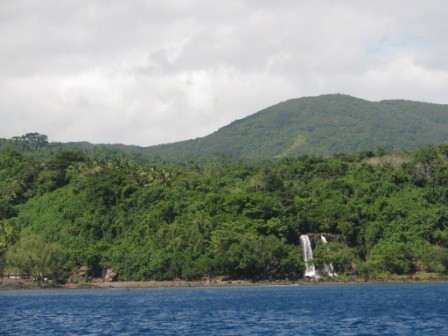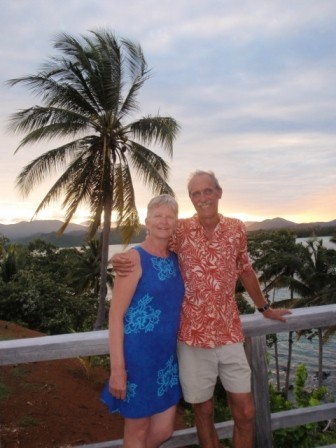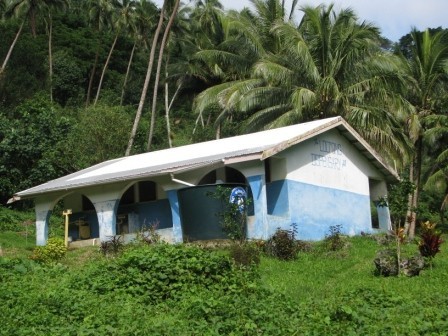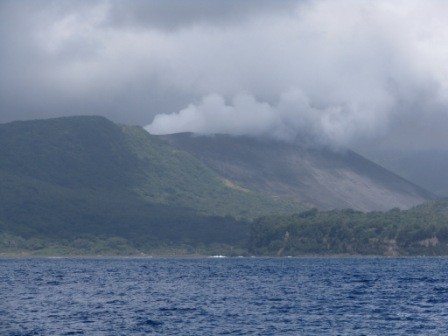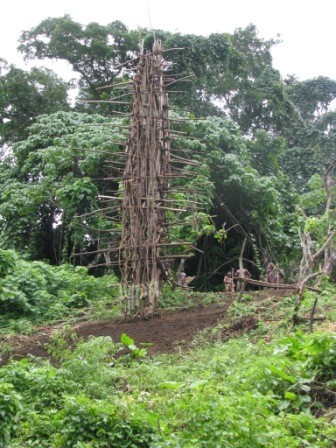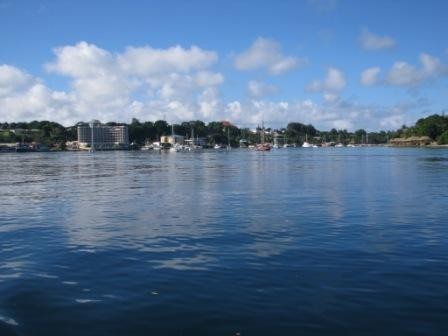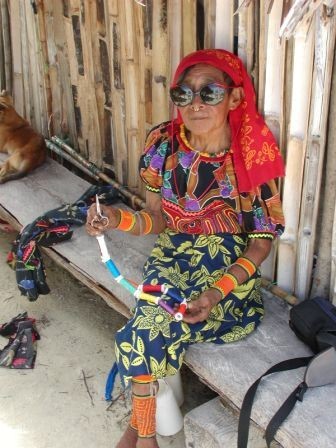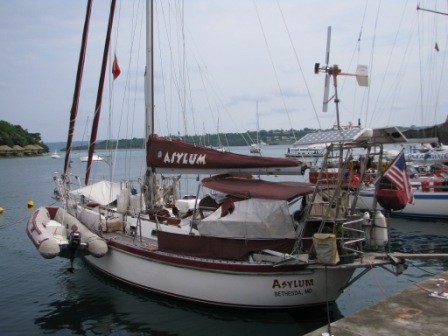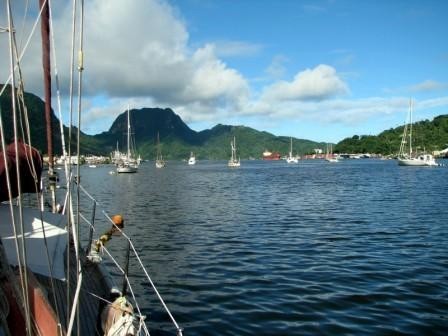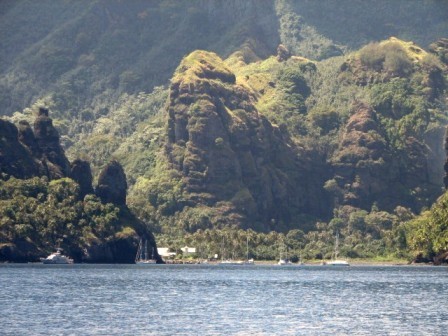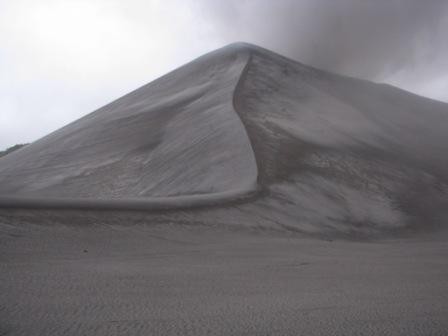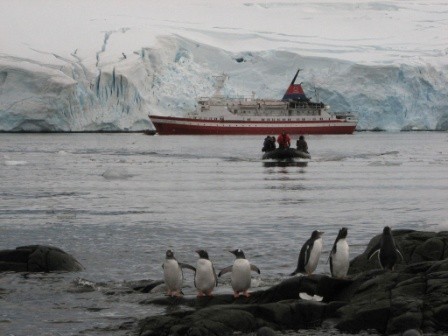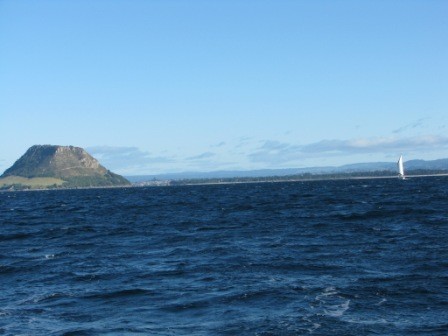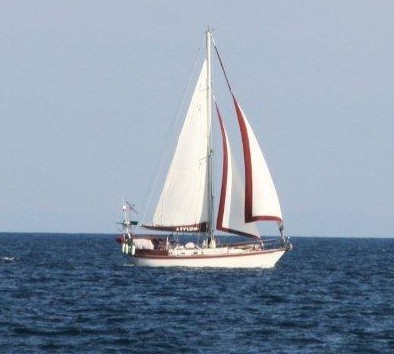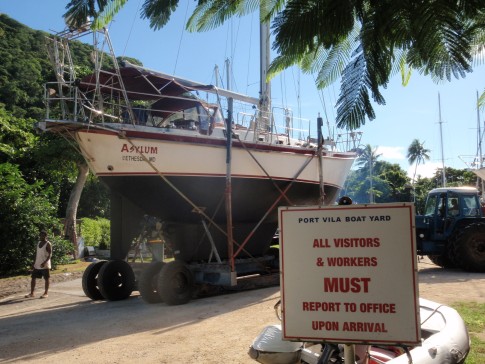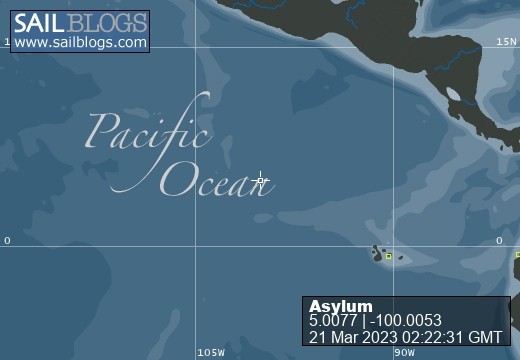
Asylum
22 June 2019 | Straits Quay Marina, Penang, Malaysia
17 July 2016 | Penang, Malaysia
20 February 2016 | Penang, Malaysia
02 October 2015 | Thailand
11 April 2015 | Krabi Boat Lagoon Marina, Thailand
25 December 2014 | Langkawi, Malaysia
04 June 2014 | Philippines
07 January 2014 | Brookeville, MD
04 July 2013 | Subic Bay Yacht Club, Philippines
31 October 2012 | Palau
02 December 2011 | Hermit Islands, Papua New Guinea
08 November 2011 | Maryland, USA
15 May 2011 | Kavieng, New Ireland, PNG
26 April 2011 | Kavieng, New Ireland
26 March 2011 | Kokopo, New Britain, Papua New Guinea
16 March 2011 | Kokopo, New Britain, Papua New Guinea
12 February 2011 | From Peava again
05 February 2011 | Solomon Islands
01 December 2010 | From Lola Island, VonaVona Lagoon, Solomon Islands
30 November 2010 | Peava, Nggatoke, Solomon Islands
Resorting to Resorts
15 May 2011 | Kavieng, New Ireland, PNG
Katie
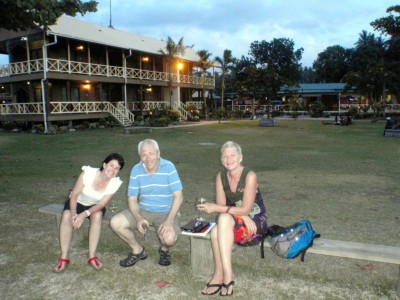
Katie with Paul and Jane Rutledge at Rapopo Plantation Resort
We don't usually make it a practice to hang out at resorts when we cruise--we'd much rather hang in gin-clear water in an isolated anchorage or off a small village getting to know the locals--but security considerations in Papua New Guinea have made resort hopping the prudent thing to do. There are some lovely anchorages and villages coming up on the next leg of the trip, which we'll explore on the way out of PNG, but until then, Resorts R Us.
Mind you, we're not complaining. These places are gorgeous and we've been generously welcomed by the hosts at our three resort stops and treated like paying guests. Which, to some extent, we are, as we treat ourselves to a dinner out now and then, but we've also had free use of moorings, swimming pools, washing machines, resort shuttles, freezers, and perhaps most valuable of all, access to local advice and information. At each place we've met a steady stream of intrepid expat residents and interesting resort guests as well, all of whom share a sort of edgy élan by virtue of living in or visiting PNG. And we've even managed to take in some of the local color and culture along the way.
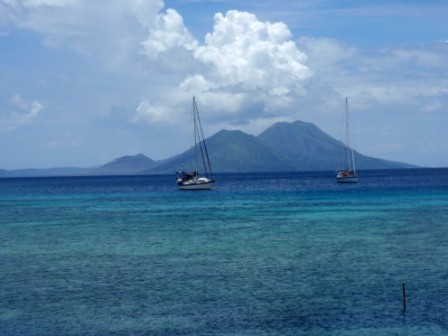
Asylum and Ariana off Rapopo resort with the Rabaul volcanoes in the background
Rapopo Plantation Resort in Kokopo took us in the day after the robbery and we stayed 2 more weeks sorting things out--getting the grate made for the V-berth hatch and making daily fruitless calls and visits to the police. It was here that we met Paul and Jane Rutledge, Paul an Aussie prosecutor working in PNG as an advisor to the court system. He was in Kokopo on a 3 week "circuit" and, bless him, tried twice on our behalf to stir up a little action in the somnambulant police department. (He had no better luck than we did.)
Kokopo became the provincial capital after nearby Rabaul was essentially buried in the 1994 volcano eruption. It has a large tidy and organized public market (compliments of a grant from the Japanese); a grandma's attic-like WW II museum crammed with musty bits of war memorabilia; lots of surrounding WW II history and sites; the best grocery stores we've found in PNG (this is important to cruisers!); and perhaps our favorite, a mobile phone store that also sells traditional shell money for when you need to pay a bride price.
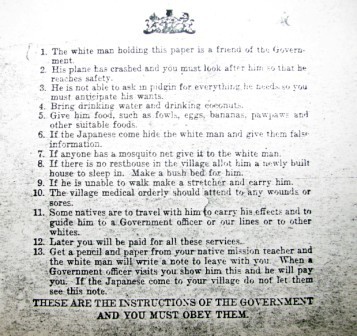
English translation of Pidjin instructions for helping stranded allied servicemen in WW II.
I like #6: "If the Japanese come hide the white man and give them false information."
I particularly like the baskets that all the men in PNG seem to carry. They come in all variety of shapes and sizes, some with fringes (my favorites) and some very tiny, some huge. Some they carry like a shoulder bag, an arm-hole woven into the design, but mostly you see them looped thru the middle finger. What I can't figure out is what's IN them. Especially the big ones??
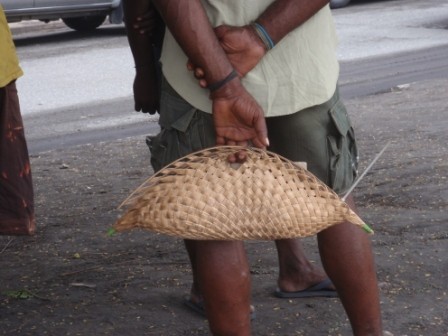
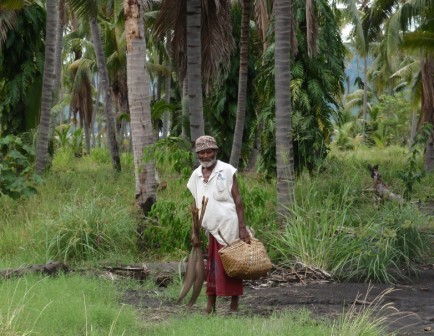
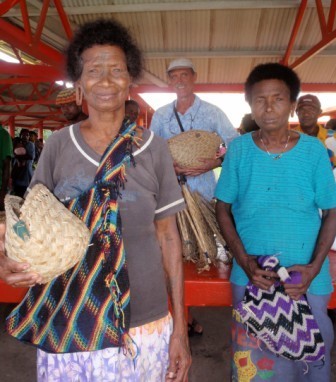
Jim buying his man-basket at the Kimbe market. These ladies, who made the baskets, had traditional face tattoos and big loopy ears. The colorful bags they're carrying are called a "bilum" and they're as common as the baskets.
From Rapopo we sailed around the top of New Britain and then south into Kimbe Bay where we stayed for about 2 weeks at the Walindi Plantation Resort near the town of Kimbe (which we'd been warned was not safe to anchor at). Walindi, too, let use a mooring (anchoring can be tricky here; the water's either very deep or you're on a reef) and we had access to the resort facilities, including an air conditioned library with cable TV (we actually watched some news!), wifi, and an extensive collection of fish books and WW II history.
The owners are an Aussie couple who've lived in PNG more than 30 years and also run an oil palm plantation - palm oil being a major source of revenue for the country. There are miles of precision-planted palm trees on these plantations, like columns of soldiers on the march. In this area they were experimenting with planting patterns to allow cattle to graze between rows of palms. Men pick the fruit from the oil palm trees with scythes attached to very long bamboo poles. They lop off the big fruits and then lug them to a pile by the side of the road, which is then picked up by a truck that works its way up and back, gathering up the piles and hauling them to the processing plant. Women and children gather the small pieces that fall out when the fruit drops.
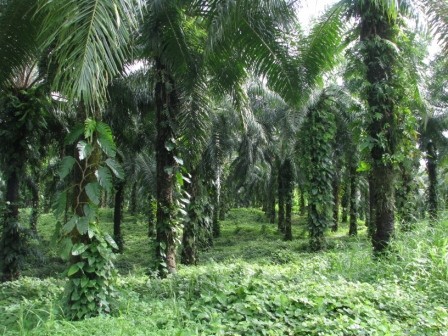
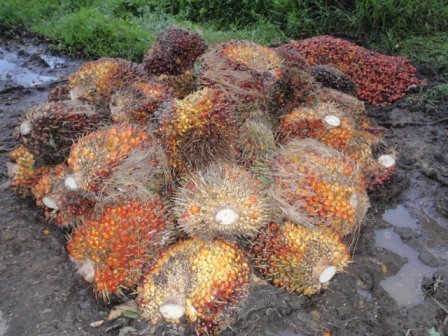
Oil palm trees and fruit waiting to be picked up for processing
Many of the plantation workers live in "company town" villages with housing provided by the palm oil company. They look a little rough to me, but apparently they're a good deal to the workers. Payday on the plantation proved to be such a problem, however, with the modern-day equivalent of stagecoach robberies each week, that the companies now find it cheaper to deliver the payroll by helicopter, which hovers over a little funnel on the roof of a locked building and drops the money bag down into it.
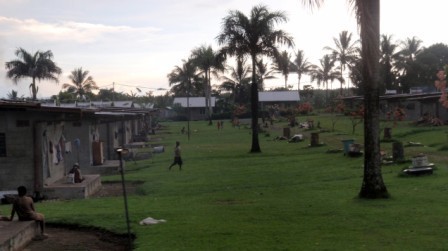
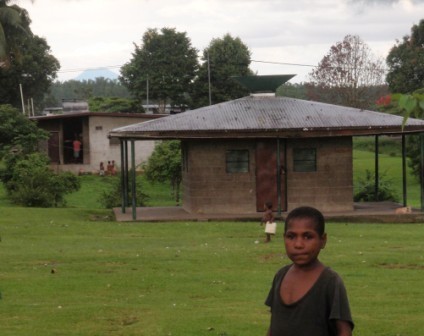
Village for plantation workers and the money drop building with the funnel on top
The resort also supports a local conservation NGO, "Mahonia Na Dari," Guardian of the Sea in the local language, that we visited. The program director asked us if we'd speak about our experience sailing around the world to a group of students they bring in every Saturday morning from area high schools to train in basic conservation and marine/reef ecology. It was an easy assignment: "Anything you want to talk about will be new and interesting to them!" so we put a few photos on a flash drive and prepared a 30 minute presentation that ended up going on for more than an hour. She said they'd probably be too shy to ask questions but I cajoled them at the end and once one of them summoned the courage to ask something, many did. I also spent several hours with the director talking about grant writing and basic program evaluation principles, something she was struggling with as their funders increasingly want to see "results." It was good to get the rusty brain cylinders pumping again and she seemed very grateful for the advice.
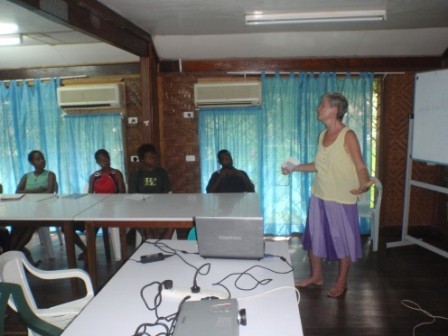
Walindi is considered a world-class dive destination and we took advantage of it while we were there. Perhaps even more interesting than the diving were some of the people we met, who come from all over the world to dive there, doing 3 and 4 dives a day. The weather didn't always cooperate but it was great diving and a first class operation. We're either not enthusiastic enough or getting old because 2 dives a day pretty much does us in. In another example of resort generosity they took in our freezer contents when our freezer started to warm up and put us in touch with their refrigeration guy who ultimately declared our compressor dead. With no replacement available anywhere in PNG, we had to order one shipped in from Australia, bound for our next destination, the town of Kavieng on the island of New Ireland.
It was a windless 34 hour motor boat ride from Walindi to Kavieng, where we dropped the hook off our third generous resort, which immediately opened their freezer to our stuff. Nusa Island Retreat is a laid back surfer/diver destination with traditional style bungalows and a bunch of native birds that come and go as they please, including a cheeky little red cardinal lorikeet named Johnny who hangs out in the bar and demands to drink from your wine glass.
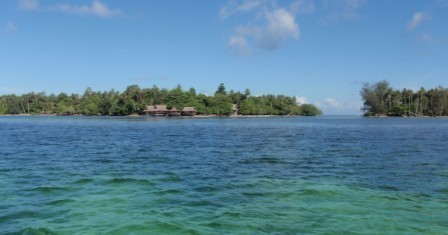
Nusa Island Retreat
Here we met the local director of another conservation NGO and were promptly invited to a mangrove-planting ceremony, with featured guest and promoter of going green, Miss PNG.
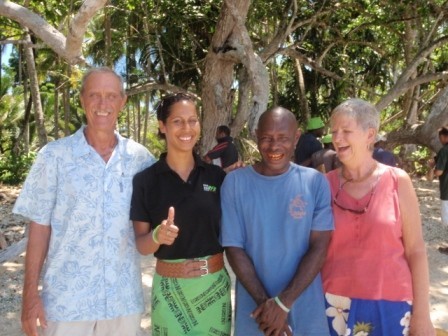
With John Aini, director of NGO "Island Awareness," and Miss PNG at the mangrove planting ceremony on Earth Day
In our regular visits to the Post Office to determine the whereabouts of our express-shipped compressor we got to know earnest young Peter, who shyly asked if could come visit the boat and was amazed that it was "just like a house!"

Peter at the cash drawer in the Kavieng PO. I was struck by the contrast of this old fashioned wood drawer, with big holes for the coins, under the counter with a modern Acer computer sitting on it.
New Ireland has the longest stretch of paved road in the country at 108 miles (amazingly, you can't drive anywhere from the capital, Port Moresby; it has about 75 miles of paved roads that don't go anywhere) and we did manage a day-trip to see some of the coastal villages. New Ireland is home to the Malagan culture, with distinctive carvings and masks used for traditional ceremonies. In the past, these items would have been destroyed after being used for a ceremony, having been imbued with too much spiritual power to safely be kept around. Usually they were buried or burned, but as interested collectors and tourists started showing up, the villagers realized they could get rid of the pieces (which was the goal) and make a little money in the process, so now many are for sale. An anthropologist whose name escapes me calls it the "sacrificial economy." The Malagan masks are very cool. I wish we could have seen them in ceremony. As it was, we just saw a small collection in a village, all securely locked in a little hut, but brought out for us to examine (and buy).

The compressor finally made it onto a plane to Kavieng and a local refrigeration guy helped Jim install it. It works. And now all too quickly it's time to press on again. Our too-short tourist visas have expired.
PNG has been a mixed bag for us: the country is painfully frustrating but equally intriguing and I wish we'd had more time to explore the intriguing parts, especially all the "sing sing" cultural festivals coming up in July - Sept. But just getting the smallest thing accomplished here requires enormous persistence and patience. We lost 2 weeks chasing the police in Kokopo and then another 2 weeks bird-dogging the Kavieng Post Office. We'd been told yes, no, no, yes that we could get extensions on our visas here in Kavieng (vs. having to send the passports to the black hole of Port Moresby). A local finally pulled some strings and got us 2 extra weeks. Jim ran around for 2 days trying to find someone in the Customs office to get the paperwork to buy duty free fuel. Local businesses were also looking for them to clear containers with supplies. Apparently it was too hot to come to work that day. When it was time for us to check out, Jim finally found the lady asleep at the office in town; never mind that she told him she'd be (sleeping?) at the one at the wharf. Nobody comes when they say they will; nothing is ready when they say it will be. It's a testament to something -- true grit? stubborn determination? cultivated imperturbability? -- that the expats who operate businesses here retain any degree of sanity. (Or maybe they don't. Seems an awful lot of alcohol is consumed...) It's not clear whether life here is just so good, all the hair-pulling hassles notwithstanding, or if life in the homeland is just so unpleasant that all the hair-pulling hassles here pale in comparison. I think the place gets into your blood, though, and the beautiful, intriguing, frontier-like (if a wee bit colonial) parts outweigh the frustrating parts and, well, maybe we all suffer from a bit of insanity now and then, doing the same thing over and over and hoping for a different result. Maybe these intrepid expats figure that one of these times things will be easy. They all seem glad to be here and all the frustrations aside, we're glad we came. Even wish we could stay longer...
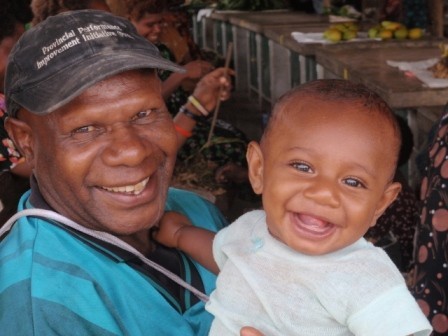
(And if you want to linger a bit longer, too, there are a few additional photos in the gallery.)
We don't usually make it a practice to hang out at resorts when we cruise--we'd much rather hang in gin-clear water in an isolated anchorage or off a small village getting to know the locals--but security considerations in Papua New Guinea have made resort hopping the prudent thing to do. There are some lovely anchorages and villages coming up on the next leg of the trip, which we'll explore on the way out of PNG, but until then, Resorts R Us.
Mind you, we're not complaining. These places are gorgeous and we've been generously welcomed by the hosts at our three resort stops and treated like paying guests. Which, to some extent, we are, as we treat ourselves to a dinner out now and then, but we've also had free use of moorings, swimming pools, washing machines, resort shuttles, freezers, and perhaps most valuable of all, access to local advice and information. At each place we've met a steady stream of intrepid expat residents and interesting resort guests as well, all of whom share a sort of edgy élan by virtue of living in or visiting PNG. And we've even managed to take in some of the local color and culture along the way.

Asylum and Ariana off Rapopo resort with the Rabaul volcanoes in the background
Rapopo Plantation Resort in Kokopo took us in the day after the robbery and we stayed 2 more weeks sorting things out--getting the grate made for the V-berth hatch and making daily fruitless calls and visits to the police. It was here that we met Paul and Jane Rutledge, Paul an Aussie prosecutor working in PNG as an advisor to the court system. He was in Kokopo on a 3 week "circuit" and, bless him, tried twice on our behalf to stir up a little action in the somnambulant police department. (He had no better luck than we did.)
Kokopo became the provincial capital after nearby Rabaul was essentially buried in the 1994 volcano eruption. It has a large tidy and organized public market (compliments of a grant from the Japanese); a grandma's attic-like WW II museum crammed with musty bits of war memorabilia; lots of surrounding WW II history and sites; the best grocery stores we've found in PNG (this is important to cruisers!); and perhaps our favorite, a mobile phone store that also sells traditional shell money for when you need to pay a bride price.

English translation of Pidjin instructions for helping stranded allied servicemen in WW II.
I like #6: "If the Japanese come hide the white man and give them false information."
I particularly like the baskets that all the men in PNG seem to carry. They come in all variety of shapes and sizes, some with fringes (my favorites) and some very tiny, some huge. Some they carry like a shoulder bag, an arm-hole woven into the design, but mostly you see them looped thru the middle finger. What I can't figure out is what's IN them. Especially the big ones??



Jim buying his man-basket at the Kimbe market. These ladies, who made the baskets, had traditional face tattoos and big loopy ears. The colorful bags they're carrying are called a "bilum" and they're as common as the baskets.
From Rapopo we sailed around the top of New Britain and then south into Kimbe Bay where we stayed for about 2 weeks at the Walindi Plantation Resort near the town of Kimbe (which we'd been warned was not safe to anchor at). Walindi, too, let use a mooring (anchoring can be tricky here; the water's either very deep or you're on a reef) and we had access to the resort facilities, including an air conditioned library with cable TV (we actually watched some news!), wifi, and an extensive collection of fish books and WW II history.
The owners are an Aussie couple who've lived in PNG more than 30 years and also run an oil palm plantation - palm oil being a major source of revenue for the country. There are miles of precision-planted palm trees on these plantations, like columns of soldiers on the march. In this area they were experimenting with planting patterns to allow cattle to graze between rows of palms. Men pick the fruit from the oil palm trees with scythes attached to very long bamboo poles. They lop off the big fruits and then lug them to a pile by the side of the road, which is then picked up by a truck that works its way up and back, gathering up the piles and hauling them to the processing plant. Women and children gather the small pieces that fall out when the fruit drops.


Oil palm trees and fruit waiting to be picked up for processing
Many of the plantation workers live in "company town" villages with housing provided by the palm oil company. They look a little rough to me, but apparently they're a good deal to the workers. Payday on the plantation proved to be such a problem, however, with the modern-day equivalent of stagecoach robberies each week, that the companies now find it cheaper to deliver the payroll by helicopter, which hovers over a little funnel on the roof of a locked building and drops the money bag down into it.


Village for plantation workers and the money drop building with the funnel on top
The resort also supports a local conservation NGO, "Mahonia Na Dari," Guardian of the Sea in the local language, that we visited. The program director asked us if we'd speak about our experience sailing around the world to a group of students they bring in every Saturday morning from area high schools to train in basic conservation and marine/reef ecology. It was an easy assignment: "Anything you want to talk about will be new and interesting to them!" so we put a few photos on a flash drive and prepared a 30 minute presentation that ended up going on for more than an hour. She said they'd probably be too shy to ask questions but I cajoled them at the end and once one of them summoned the courage to ask something, many did. I also spent several hours with the director talking about grant writing and basic program evaluation principles, something she was struggling with as their funders increasingly want to see "results." It was good to get the rusty brain cylinders pumping again and she seemed very grateful for the advice.

Walindi is considered a world-class dive destination and we took advantage of it while we were there. Perhaps even more interesting than the diving were some of the people we met, who come from all over the world to dive there, doing 3 and 4 dives a day. The weather didn't always cooperate but it was great diving and a first class operation. We're either not enthusiastic enough or getting old because 2 dives a day pretty much does us in. In another example of resort generosity they took in our freezer contents when our freezer started to warm up and put us in touch with their refrigeration guy who ultimately declared our compressor dead. With no replacement available anywhere in PNG, we had to order one shipped in from Australia, bound for our next destination, the town of Kavieng on the island of New Ireland.
It was a windless 34 hour motor boat ride from Walindi to Kavieng, where we dropped the hook off our third generous resort, which immediately opened their freezer to our stuff. Nusa Island Retreat is a laid back surfer/diver destination with traditional style bungalows and a bunch of native birds that come and go as they please, including a cheeky little red cardinal lorikeet named Johnny who hangs out in the bar and demands to drink from your wine glass.

Nusa Island Retreat
Here we met the local director of another conservation NGO and were promptly invited to a mangrove-planting ceremony, with featured guest and promoter of going green, Miss PNG.

With John Aini, director of NGO "Island Awareness," and Miss PNG at the mangrove planting ceremony on Earth Day
In our regular visits to the Post Office to determine the whereabouts of our express-shipped compressor we got to know earnest young Peter, who shyly asked if could come visit the boat and was amazed that it was "just like a house!"

Peter at the cash drawer in the Kavieng PO. I was struck by the contrast of this old fashioned wood drawer, with big holes for the coins, under the counter with a modern Acer computer sitting on it.
New Ireland has the longest stretch of paved road in the country at 108 miles (amazingly, you can't drive anywhere from the capital, Port Moresby; it has about 75 miles of paved roads that don't go anywhere) and we did manage a day-trip to see some of the coastal villages. New Ireland is home to the Malagan culture, with distinctive carvings and masks used for traditional ceremonies. In the past, these items would have been destroyed after being used for a ceremony, having been imbued with too much spiritual power to safely be kept around. Usually they were buried or burned, but as interested collectors and tourists started showing up, the villagers realized they could get rid of the pieces (which was the goal) and make a little money in the process, so now many are for sale. An anthropologist whose name escapes me calls it the "sacrificial economy." The Malagan masks are very cool. I wish we could have seen them in ceremony. As it was, we just saw a small collection in a village, all securely locked in a little hut, but brought out for us to examine (and buy).

The compressor finally made it onto a plane to Kavieng and a local refrigeration guy helped Jim install it. It works. And now all too quickly it's time to press on again. Our too-short tourist visas have expired.
PNG has been a mixed bag for us: the country is painfully frustrating but equally intriguing and I wish we'd had more time to explore the intriguing parts, especially all the "sing sing" cultural festivals coming up in July - Sept. But just getting the smallest thing accomplished here requires enormous persistence and patience. We lost 2 weeks chasing the police in Kokopo and then another 2 weeks bird-dogging the Kavieng Post Office. We'd been told yes, no, no, yes that we could get extensions on our visas here in Kavieng (vs. having to send the passports to the black hole of Port Moresby). A local finally pulled some strings and got us 2 extra weeks. Jim ran around for 2 days trying to find someone in the Customs office to get the paperwork to buy duty free fuel. Local businesses were also looking for them to clear containers with supplies. Apparently it was too hot to come to work that day. When it was time for us to check out, Jim finally found the lady asleep at the office in town; never mind that she told him she'd be (sleeping?) at the one at the wharf. Nobody comes when they say they will; nothing is ready when they say it will be. It's a testament to something -- true grit? stubborn determination? cultivated imperturbability? -- that the expats who operate businesses here retain any degree of sanity. (Or maybe they don't. Seems an awful lot of alcohol is consumed...) It's not clear whether life here is just so good, all the hair-pulling hassles notwithstanding, or if life in the homeland is just so unpleasant that all the hair-pulling hassles here pale in comparison. I think the place gets into your blood, though, and the beautiful, intriguing, frontier-like (if a wee bit colonial) parts outweigh the frustrating parts and, well, maybe we all suffer from a bit of insanity now and then, doing the same thing over and over and hoping for a different result. Maybe these intrepid expats figure that one of these times things will be easy. They all seem glad to be here and all the frustrations aside, we're glad we came. Even wish we could stay longer...

(And if you want to linger a bit longer, too, there are a few additional photos in the gallery.)
Comments
| Vessel Name: | Asylum |
| Vessel Make/Model: | Tayana V-42 Cutter |
| Hailing Port: | Bethesda, MD USA |
| Crew: | Jim & Katie Coolbaugh |
| About: | |
| Extra: | Within Malaysia: 0174209362 (Maxis) WhatsApp +60174209362 |
The Meanderings of Asylum and the Inmates
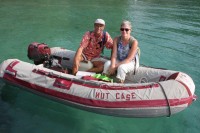
Who: Jim & Katie Coolbaugh
Port: Bethesda, MD USA
Where in the world is Asylum?
Good links
- Vesper Marine Watchmate AIS
- WinchRite Cordless Winch Handle
- Diving at Tubbataha Reef
- Royal Belau Yacht Club, Palau
- ShipTrack: Our route so far
- Passage Weather
- Interview With a Cruiser Project
- Great diving in the Solomons
- Seven Seas Cruising Association
- Divers Alert Network
- Spectra Watermakers
- Rocna Anchors
.jpeg)
